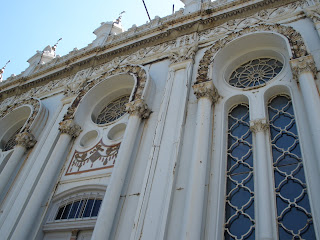The Sabanci family is a well established industrial family in many business sectors in Turkey. There is also a university and a museum in Emirgan, on the Bosphorus.
The museum is housed in what was once a family home, called the horse house, due to the horse statues at the Bosphorus level and also the higher house level.
The museum has an exhibit titled "Across - The Cyclades and Western Anatolia during the 3rd Millenium BC". The Cyclades are Greek islands between modern day Turkey and Greece, which have been inhabited and have traded with coastal Anatolia (the Asian side of Turkey) for milleniums. The large sign out front depicts one of the artifacts on loan from a Greek museum.
There are also artifacts from several Turkish museums, all of which date to the time period 3000 BC to 2000 BC.
A map in the gift shop shows the islands. Although unreadable in my picture, each of the white words represent an inhabited location during that time period. A wooden boat was used by these peoples to row between the islands and the coasts of the adjacent mainlands.
The museum does not allow photography, but they do have school groups, who tour the exhibits and then work on creating their own artifact out of white clay. Without needing to dry, the students were able to use markers to color their artwork. When I asked in English, if I could take a picture, the heads nodded "yes" and the mouths sent the message of "yabanci" or foreigner down the row.
The Sakip Sabanci museum is on a beautiful piece of property with views of the Bosphorus, and ...
beautiful gardens, ...
with artifacts displayed throughout. And just when you think you might want to stretch out on the grass, ...
that spot is taken by another lovely artifact.
A stop by the waterfall and water lily pond, ...
to say goodbye to the resident frog.
More information about the museum is available at
www.muze.sabanciuniv.edu The current exhibit is on display until August 28, 2011.



















































